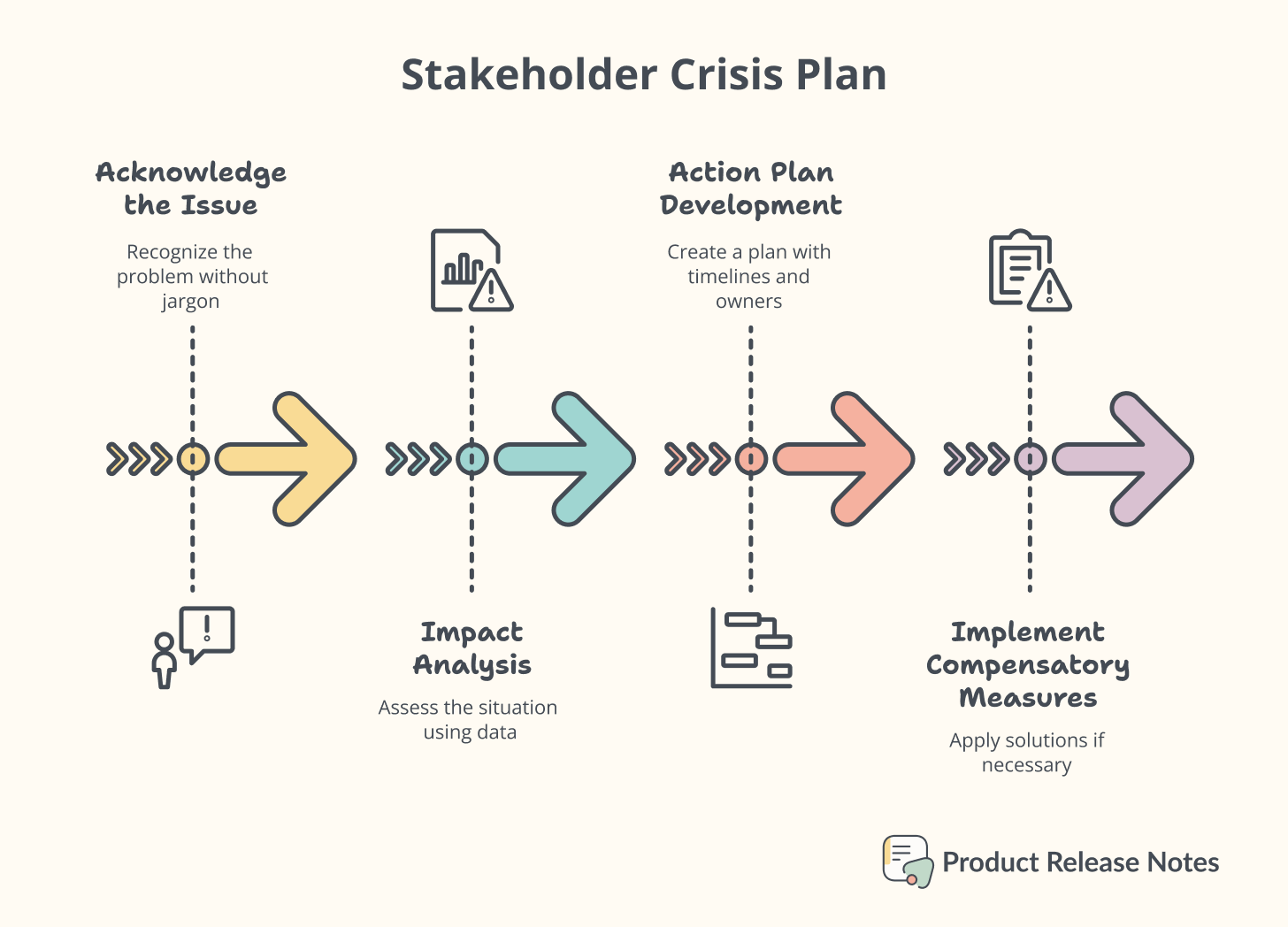Release Failed: What To Do In The First 24 Hours
Discover actionable strategies to navigate post-release chaos while maintaining stakeholder trust. Here's your playbook for transforming setbacks into strategic wins.
You’ve just finished the quarterly stakeholder call where you confidently announced next week’s major feature release. Two days later, your QA lead slides into your Teams DMs: “We found a showstopper bug in UAT.” Your stomach drops. Sound familiar?
As product managers, we’ve all faced that moment where reality collides with our carefully crafted plans. But here’s the truth no one tells you: How you handle failure defines your leadership more than any flawless launch ever could.
🚨 Immediate Damage Control
1. Triage Like an ER Surgeon
If you have seen ER (Emergency Room), Grey's Anatomy or Chicago Med, then you get the idea of triage where characters must make rapid decisions to prioritize patients' care.
Triaging in Product Management it’s about making rapid decisions to prioritize our product and user’s care.
Understanding the gravity of the situation, gather your core team for an emergency stand-up meeting. Assess the severity of the issue: Is it truly a showstopper, or is it a minor inconvenience that can be fixed quickly? Not every bug has the same level of impact, and a clear assessment will guide your next steps.
That being said, here’s a severity assessment matrix I live by:
💡 Pro Tip: Use your engineering team’s MTTR (Mean Time to Repair) data from past incidents to set realistic expectations.
Why? ⁉️
There is nothing worse for the customer than relying on false promises. Having a bug is one thing, it has already happened, but over-promising the real solution can be very damaging.
How To Use the Severity Matrix 🚦
Let’s use a hypothetical scenario:
Your team is preparing to launch a new mobile banking app that allows users to check balances, transfer funds, and make payments. Just before the launch, several issues are discovered during final testing. Ouch!
Let's see how these would be classified using the severity matrix. Issue Classification 👇
1️⃣ Issue: Login Screen Crash
Description: The app crashes for 5% of users when attempting to log in.
Severity: High (3)
Priority: High (2)
Rationale: This issue directly impacts core functionality and prevents a portion of users from accessing the app at all. While it doesn't affect all users, it's a critical entry point.
2️⃣ Issue: Incorrect Balance Display
Description: Account balances are occasionally displayed incorrectly, showing outdated information.
Severity: Critical (4)
Priority: Immediate (1)
Rationale: This issue could lead to significant financial consequences for users and damage trust in the app. It affects a core feature and has potential legal implications.
3️⃣ Issue: Slow Loading of Transaction History
Description: The transaction history page takes 10-15 seconds to load on older devices.
Severity: Medium (2)
Priority: Moderate (3)
Rationale: While inconvenient, this issue doesn't prevent core functionality. It affects user experience but doesn't pose immediate risks.
4️⃣ Issue: Cosmetic UI Glitch in Settings Menu
Description: Some icons in the settings menu are misaligned on certain screen sizes.
Severity: Low (1)
Priority: Low (4)
Rationale: This issue is purely cosmetic and doesn't impact functionality. It's noticeable but doesn't affect the user's ability to use the app.
Example’s Prioritization and Action Plan 🔺
Based on the severity matrix, the team would prioritize fixing these issues as follows:
Incorrect Balance Display: This gets immediate attention due to its critical severity and high priority. The team should allocate resources to fix this before launch, even if it means delaying the release.
Login Screen Crash: While not affecting all users, this high-severity issue needs to be addressed quickly. The team should investigate the cause and implement a fix as soon as possible.
Slow Loading of Transaction History: This issue should be addressed in the next update cycle. The team can work on optimizing performance for older devices.
Cosmetic UI Glitch: This low-priority issue can be added to the backlog for future UI refinements.
Sometimes that's easier said than done, but hey you get it...
2. Stakeholder Crisis Plan
Once you have effectively triaged the issues at hand, it’s time to shift your focus to communication—a vital aspect of this crisis management. Transparent communication with stakeholders can mitigate panic, maintain trust, and foster collaboration.
Here’s a template that saved relationships for me in the past:
✉️ Subject: Update on [Feature] Release - Transparent Next Steps
📝 Key Message Structure:
Acknowledge the issue (no corporate jargon!)
Impact analysis (numbers > adjectives)
Action plan with timeline owners
Compensatory measures (if applicable)
Example:
“During final testing, we identified a payment processing bottleneck affecting 1 in 3 transactions under peak load.
While disappointing, catching this now prevents larger customer impact. Our engineering lead X is leading the fix, targeting resolution by EoW.
All affected customers will receive double loyalty points for their next purchase.”*There’s other ways to compensate users like coupon codes, special access, unlocking other features, etc.
🔑 Golden Rule: Send updates before stakeholders ask. I schedule 3 touch points: Initial alert → Progress update at 50% resolution → Final resolution.
3. The Post-Mortem That Prevents Repeat Failures
Blameless Root Cause Analysis Formula
(Stolen from aviation incident investigations)
1. Timeline Reconstruction:
Map decision points from roadmap approval to UAT
Highlight 3-5 critical junctures where detection failed
2. "Five Whys" Exercise:
Why did the bug reach UAT? → Test coverage gap in load scenarios Why? → Performance testing de-prioritized for speed Why? → Stakeholder pressure for Q1 launch... (make sure to get to the bottom of it, sometimes it just asking the right questions).
3. How to Prevent:
Add performance testing checklist to Definition of Done.
Implement automated load testing thresholds.
Create escalation path for timeline vs quality tradeoffs.
💡 Pro Tip: Share the raw post-mortem (minus sensitive details) with stakeholders. Transparency builds credibility.
4. Building Anti-Fragile Release Processes
The Resilience Stack in Tech
After some unsuccessful experiences this is what we have learned:
Pre-Mortems: Before major releases, we ask: “What’s the most likely catastrophic failure?” and game plan responses.
Dark Launches: Gradual feature exposure to 5% → 20% → 100% user base
Dark Launches are a great way to do even A/B testing. But your product's technology stack need to have Feature Flags/Toggles so that dynamic feature activation without redeployment is possible.
It worth’s the investment as Dark releases emerged as a solution to these problems, enabling controlled, incremental and less disruptive feature deployment, while emphasizing risk mitigation, user feedback and continuous improvement.
Chaos Engineering Lite: Bi-Weekly “break things” sessions where we simulate failures to test our systems' responses and resilience. This proactive approach not only uncovers potential weaknesses but also empowers the team to devise contingency plans ahead of time.
Stakeholder Immune System: Quarterly “What If” scenario workshops with leadership and cross-functional teams to discuss possible crises and response strategies. These workshops build a shared understanding of risks and create a culture of readiness, ensuring that when the unexpected happens, you have a playbook ready to execute.
💬 Last Thoughts
Reframing the Narrative: From Failure to Strategic Pivot 🚀
When crises hit, it's easy to slip into a defensive posture. However, adopting a growth mindset can transform the narrative around failure.
When something goes wrong with my team, I publicly give credit to the engineering team for spotting the problem.
Rather than viewing setbacks as impossible obstacles, see them as rich learning opportunities not just for you but for your team. Encourage your team to engage in open dialogue about what went wrong and celebrate the lessons learned along the way.
Remember: The market doesn’t judge products—it judges how you evolve them. Your greatest features might be born from your messiest failures.
Here are 3 Product Mantras I try to live by:
“All launches are beta tests with better marketing”
“Stakeholders remember recovery speed, not failure duration”
“Every crisis contains the DNA of your next innovation”
And I’ll close with this quote that a manager once told me:
“A smooth sea never made a skilled sailor.”
― Franklin D. Roosevelt






